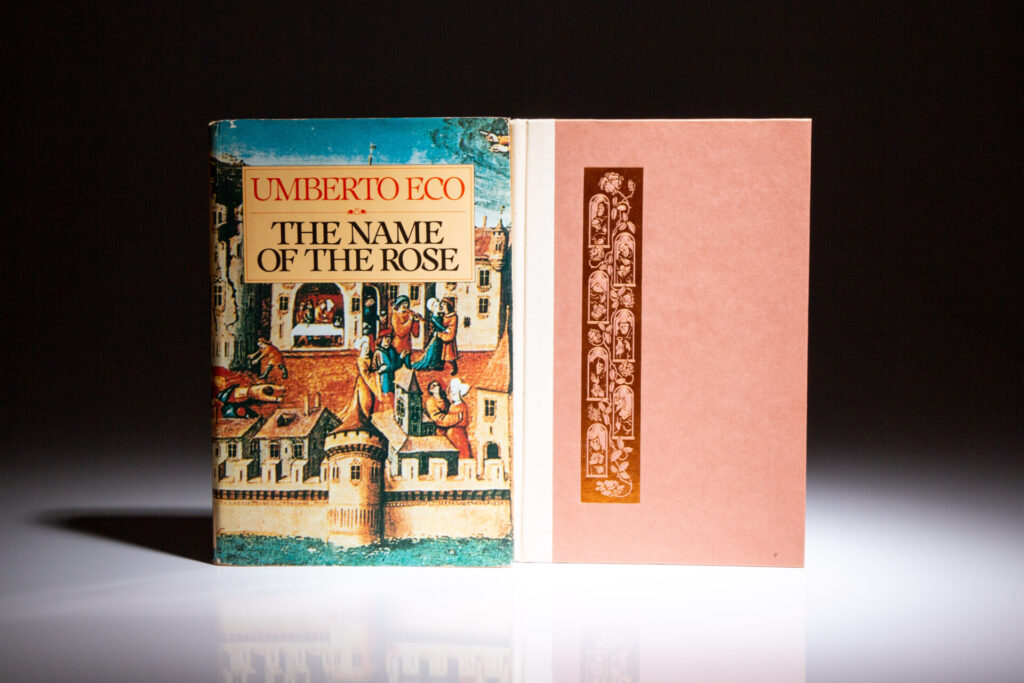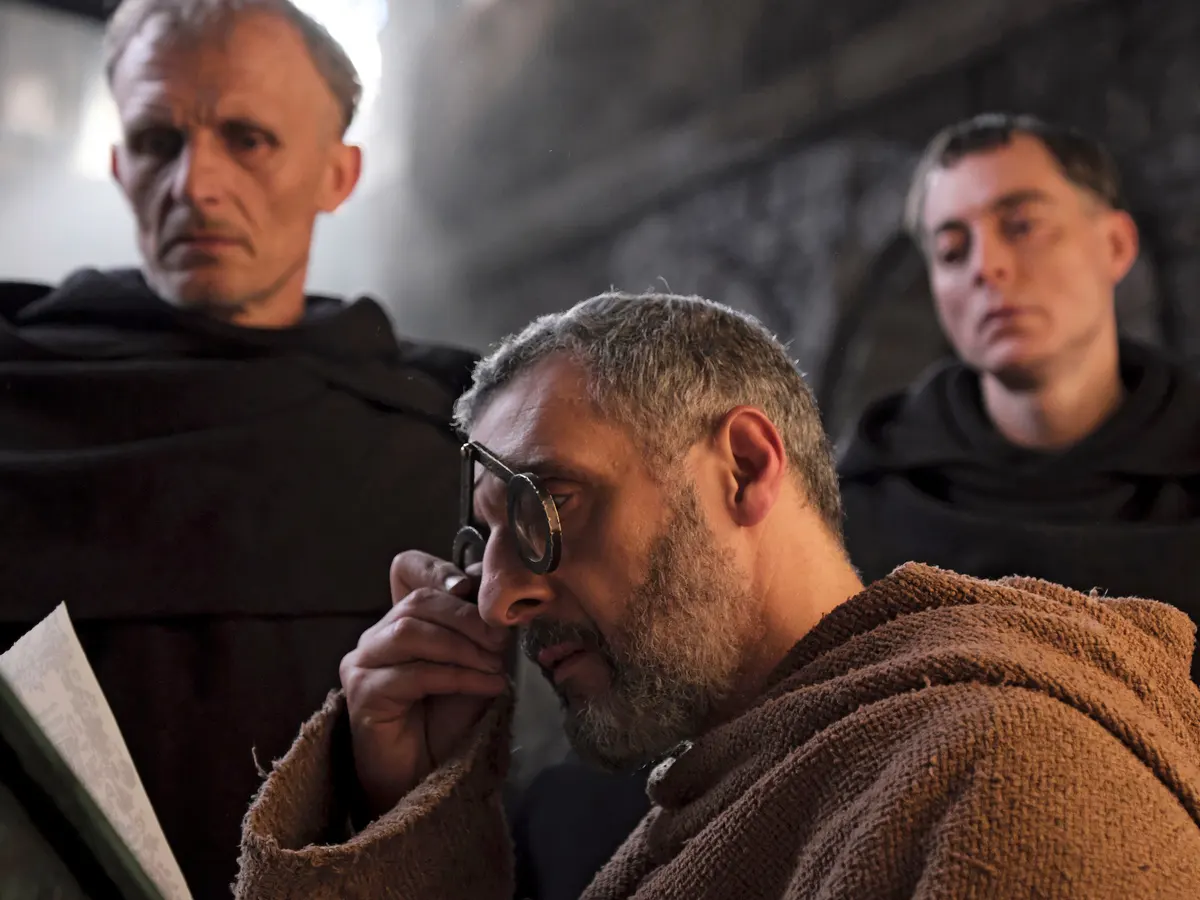Umberto Eco’s literary masterpiece, The Name of the Rose, was adapted to the screen in 1986. Here’s a discussion of the challenges in adapting Eco’s novel and how the filmmakers overcome them in the course of the movie.
Adapting a beloved book to the silver screen has long been a topic of discussion between those who prefer to read a book and those who prefer watching a movie. Let’s just say that adaptation is a complex process. It requires a balance between faithfulness to the original text and the required changes and modifications to suit a visual medium.
Umberto Eco’s The Name of the Rose is a prominent example of the challenges that a filmmaker faces in the process of adapting a book to the screen. First published in 1980 to critical and commercial success, this historical murder mystery is famous for featuring an intricately crafted plot, an intellectual core, and a deep exploration of life in a medieval abbey. The novel is set in 1327. It follows the Franciscan friar William of Baskerville, assisted by his protégé Adso of Melk, as they investigate a series of mysterious deaths in the isolated abbey. Filled with multiple plot twists, numerous theological and doctrinal debates, and philosophical reflections, The Name of the Rose offers the perfect concoction of murder, mysterious symbols, maps, and old books.
However, adapting Eco’s masterpiece into an understandable film was a daunting task. It required depicting the suspenseful aspects of the story while keeping the philosophical discussions and historical background against which Eco’s novel was set intact. Further, filmmakers were faced with the trouble of adapting the rich descriptions of the text and the numerous intellectually stimulating dialogues and their symbolism – all of which were crucial elements of the novel.
Let’s explore how The Name of the Rose was adapted into a movie (1986) by listing and examining many choices made during the adaptation process. I will try to study the changes that were made to the narrative, how the abbey was brought to life and the shift in perspective from the book when adapting it into a movie.
Historical Setting of the Novel vs. the Movie Adaptation
In the book, Eco dedicates several chapters to elaborate on the historical background and political dynamics of the time when the novel is set – 1327.
It reveals a power struggle between Pope John and Emperor Clement, the ruler of the Holy Roman Empire, which ultimately led to the emperor declaring the Pope a heretic. This conflict also caused a division within the religious world as the clergy found themselves stuck between the difficult choice of their loyalty to the emperor and their allegiance to the Holy Roman Church. Further, the religious landscape had already evolved into a complex organization consisting of various religious groups with differing interpretations of the Holy Scriptures. These divisions led to tensions and conflicts among the orders, with some – like the Dolcinites – being considered criminal and heretical and leading to their eradication by the Inquisition.
However, in the movie adaptation, much of this intricate historical background is omitted. It only bears passing references to the Dolcinite heretics and a general acknowledgment of the precarious position of the Franciscan friars, who were granted safety under the emperor despite the Pope’s objections. The focus of the film centers on the suspenseful murder mystery, full of heightened tension, while elaborate historicity occupies a secondary position. The religious differences between various competing sects and their governing philosophies with the ideologies of the monks at the abbey are omitted as well.
The movie adaptation does, as a direct consequence of all this, lose some of the flavor of Eco’s writing and is consequently less immersive. Many of the characters present at the abbey are not well-rounded, and viewers know little to nothing about them outside of their direct involvement with the investigation. Some monks – such as Benno of Upsul (who helps Adso and William but is simultaneously a suspect) and Alinardo (the eldest monk still alive at the abbey) – are absent from the film adaptation.
Changes to the Narrative: Book vs. Movie Adaptation

One of the primary challenges in adapting The Name of the Rose was condensing its expansive narrative. Eco’s novel weaves a tapestry of multiple storylines, rich historical details, and philosophical debates, immersing readers in the intricacies of the 14th-century abbey. However, the limited runtime of a movie necessitated streamlining the plot and focusing on its core elements. Director Jean-Jacques Annaud, in collaboration with screenwriter Andrew Birkin, had to make some difficult choices in making the movie adaptation. This led to the omission and condensation of certain subplots to maintain a cohesive and engaging cinematic experience for the audience.
For instance, the extensive theological discussions among the characters, a prominent feature of the book, are largely excluded from the film. Only the discussion about laughter and comedy, which holds central importance to the story’s overarching plot and climax, is retained in the movie adaptation. This is because most of these discussions did not have any bearing on the main plot of the movie, which is understandably the focus given the relative lack of time in watching a movie, as opposed to reading a lengthy book.
Also, read:Lady Chatterley’s Lover (2022) Review
Visualizing the Words: Book vs. Movie Adaptation
Visualizing the vast historical setting of The Name of the Rose presented its own set of unique challenges for the filmmakers. Eco offered detailed descriptions of different parts of the medieval abbey, using his words to paint vivid pictures of the architecture of the abbey as a whole and the manuscripts in the library, among others. He also created a bleak atmospheric setting to keep up with the seriousness of the plot and the themes it explores.
The filmmakers had to undertake the difficult job of recreating a genuine version of this world for their audience while adding some unique touches to them.
The abbey – the setting of the movie, which is central to all events taking place – needed to be brought to life, and they set about doing so through meticulous production design, evocative cinematography techniques, and skilful use of locations. They succeeded in their efforts, as the film successfully transports the audience to the grim yet enchanting world of the abbey. It brings to life the abbey’s dark corridors, candlelit scriptorium, and towering library, capturing the essence of Eco’s vision.
The secluded environment and distinctive geometric structure of the monastery, which play a pivotal role in Eco’s narrative, are also faithfully brought to life in accordance with the book’s meticulous descriptions. Further, the bestiary, intricately carved into the church doorway, is brought to life in its full glory, adding to the abbey’s dark, foreboding atmosphere.
The cold and grey colour palette of the film succeeds in capturing the atmosphere of the “dark north of Italy”, where the novel is set. The actors – predominantly European – are carefully styled with makeup and hair that transform them into figures reminiscent of medieval illustrations, thus creating a sense of authenticity and period-appropriate aesthetics. This depiction also brings the film adaptation closer to the novel in a visual way and adds to the setting of the story.
A Shift in Perspective: Book vs Movie Adaptation
Both the book and the movie let the story unfold as a narrative in retrospect from the perspective of a young novice monk, Adso of Melk. This provides the readers and the audience with a firsthand account of events at the abbey, allowing Adso’s experiences and observations to shape our ideas of the story as he navigates the grim corridors alongside his mentor, William of Baskerville.
Eco utilises Adso’s point of view to allow for introspection and reflection on events gone by. Through Adso’s inner monologue, book readers gain a greater understanding of his evolving thoughts, emotions, opinions and character development throughout the story. Adso’s perspective acts as a lens through which the reader immerses themselves into the lives and deaths in the abbey or the overall mystery. This enables us to understand his curiosity, growth, moral dilemmas and journey towards maturity.
While the movie adaptation also retains Adso’s perspective through the use of voiceovers, it is, nonetheless, quite different from the book. This is primarily due to the limitations of the visual medium. The movie depends more on visual cues to convey Adso’s perspective. Through the clever usage of close-up shots, camera angles and a moody atmosphere, viewers can see Adso’s emotions, such as awe, fear, curiosity and intrigue, as the movie plot progresses.
Though this was a disadvantage in a manner of speaking, the movie adaptation takes advantage of its visual nature to provide new perspectives not present in the book. This is done by expanding beyond Adso’s perspective for certain scenes and subplots that show events occurring beyond Adso’s immediate presence. An example of this is a scene where Abbot, Malachia, and Jorge engage in conversation, deliberating whether seeking William’s assistance in solving Adelmo’s death is the right course of action. Doing so allows the audience a greater, more nuanced understanding of the events at the abbey, especially in terms of relationships between characters, politics and religion.
This is also best seen through the addition of several scenes featuring the Inquisitor Bernard Gui and his past relationship with William of Baskerville. These moments provide a broader viewpoint of the historical context and add to the story as a whole, enhancing the setting, which makes this aspect of the movie more engaging than the novel.
Also Read: Do Faithful Movie Adaptations Work?
Summing up
The adaptation of Umberto Eco’s The Name of the Rose presented filmmakers with the unenviable task of adapting a very popular and complex novel to the big screen. Condensing the narrative, portraying layered characters with complicated backstories, bringing to life a detailed historical setting, and the sometimes hard-to-follow philosophizing all required careful consideration followed by decisive choices. While it is inevitable that there would be changes, compromises, sacrifices, and even additions, the film succeeded in capturing the heart of Eco’s novel and bringing its absorbing world to life.

